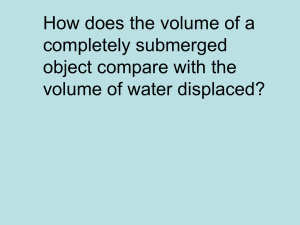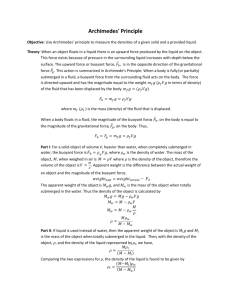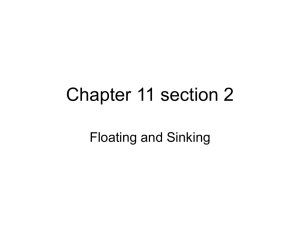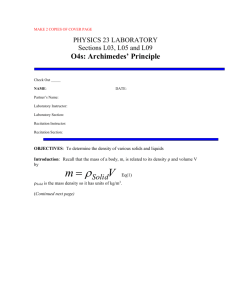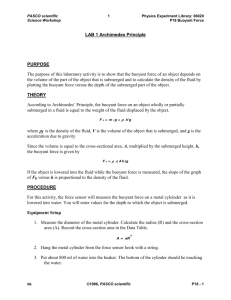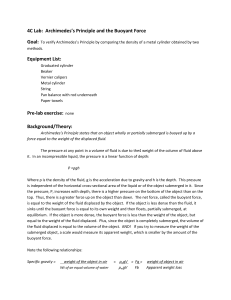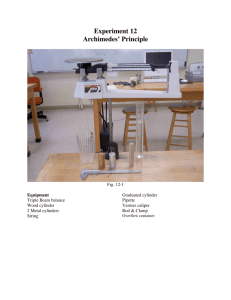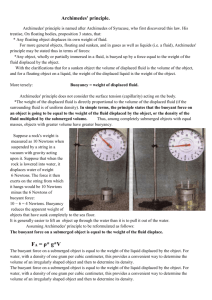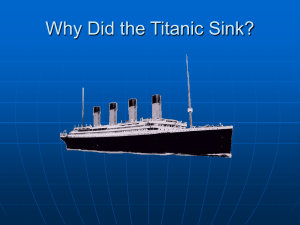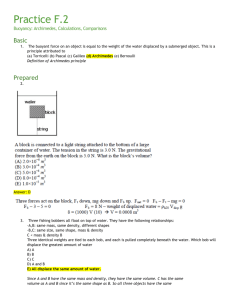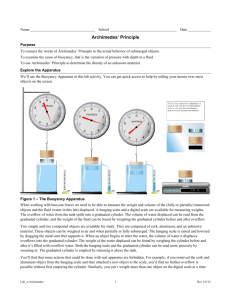Experiment 10: Archimedes' Principle
advertisement
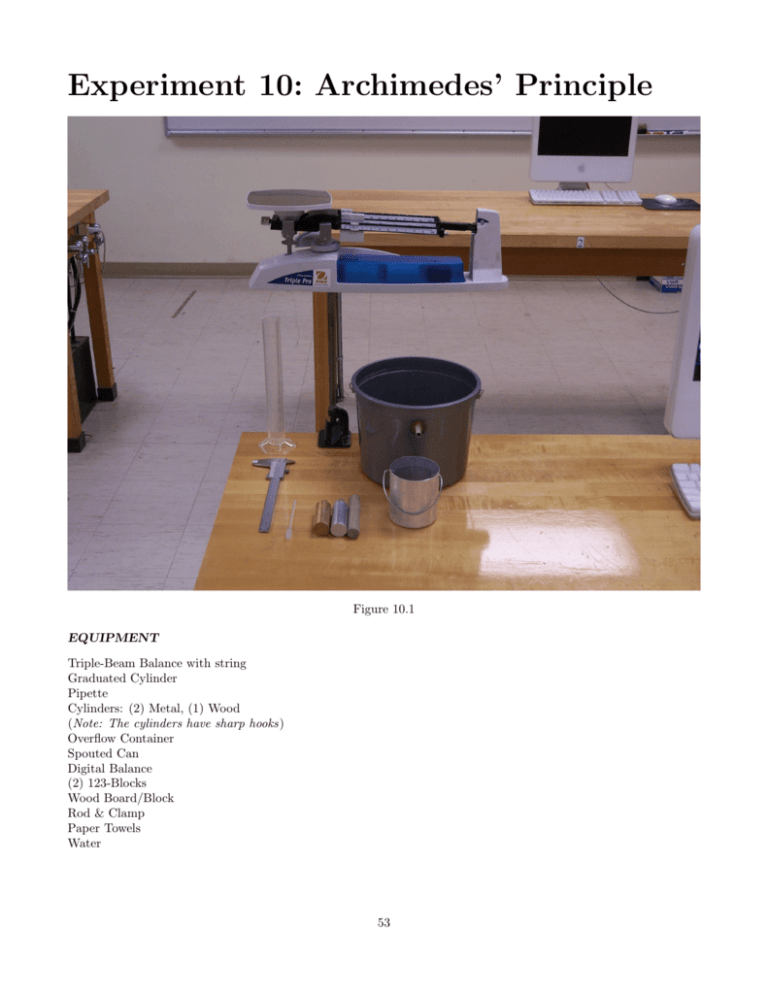
Experiment 10: Archimedes’ Principle Figure 10.1 EQUIPMENT Triple-Beam Balance with string Graduated Cylinder Pipette Cylinders: (2) Metal, (1) Wood (Note: The cylinders have sharp hooks) Overflow Container Spouted Can Digital Balance (2) 123-Blocks Wood Board/Block Rod & Clamp Paper Towels Water 53 Experiment 10: Archimedes’ Principle 54 Advance Reading Text: Archimedes’ principle, buoyant force, density Objective The objective of this lab is to investigate the buoyant force acting on a variety of objects, the density of the objects, and the density of our tap water. Theory Archimedes’ principle states that a body wholly or partially submerged in a fluid is buoyed up by a force equal in magnitude to the weight of the fluid displaced by the body. It is the buoyant force that keeps ships afloat (object partially submerged in liquid) and hot air balloons aloft (object wholly submerged in gas). We will investigate the buoyant force using the following methods: • Direct Measurement of Mass • Displacement Method When an object is submerged in water, its weight decreases by an amount equal to the buoyant force. The direct measurement of mass will measure the weight of an object first in air, then while it is submerged in water. The buoyant force, FB , is equal to the weight in air (Fg ) minus the weight in water, Fg0 = m0 g: FB = Fg Fg0 (10.1) The displacement method requires measurement of the volume of fluid displaced by the object. The weight of the fluid displaced is equal to the buoyant force exerted on the object. Thus, the buoyant force is given by: FB = ⇢gV (10.2) where ⇢ (Greek letter, rho) is the density of the fluid displaced, V is the volume of fluid displaced by the object, and g is the acceleration due to gravity. The following exercises will be informative, as both floating and sinking objects are used in this experiment. • Sketch a free-body diagram for an object that is floating in water. How much water does it displace? Does it displace its volume in water? Does it displace its weight in water? • Sketch a free-body diagram for an object that is submerged in water. How much water does it displace? Does it displace its volume in water? Does it displace its weight in water? The accepted value for the density of pure water at 4 C and 1 atm is ⇢water = (1000 ± 1) kg/m3 . We will use this value for the density of water for Part 2 through Part 5. That is, we assume a temperature in the lab of 4 C! We will then experimentally determine the density of the tap water we used (Part 6) and compare it to the density of water at 20 C. The density of pure water at 20 C is: ⇢water = (998.21 ± 0.01) kg/m 3 (10.3) When comparing the experimental densities of your objects or tap water, please use Table 1.1 provided at the end of Experiment 1: Measurement & Analysis on Page 9. Prelab 10: Archimedes’ Principle 55 Name: 1. State Archimedes’ principle. (20 pts) 2. Explain the relationship FB = ⇢V g. (25 pts) 3. Briefly explain the methods used in Part 1 through Part 3 of this experiment to determine buoyant force. (25 pts) 4. Draw a free-body diagram for an object of mass M , for the following two situations: a. a submerged object suspended by a string; b. a floating object. Draw to scale. (30 pts) Experiment 10: Archimedes’ Principle 56 PROCEDURE PART 4: Aluminum Cylinder PART 1: Overflow Method 1. Measure the mass of the brass cylinder. Determine its weight, Fg . 2. Place the overflow container on the digital balance. 3. Fill the spouted can with water. Position it so that its spigot pours into the overflow container. 4. Submerge the brass cylinder in the water, allowing displaced water to collect in the overflow container. 5. Measure the mass of the displaced water; calculate its weight. This is the buoyant force, FB . 6. Calculate ⇢obj (density of the object): ⇢obj ⇢W F g = FB (10.4) 17. Repeat Part 1 through Part 3 for the next object (aluminum cylinder). 18. Draw a free-body diagram for this object submerged in water. PART 5: Buoyant Force - Floating Object 19. Although you need to modify or omit certain steps, repeat Part 1 through Part 3 for the wood cylinder: • Omit Step 6, Step 11, and Step 16. • Modify Step 9 and Step 13: Allow the wood object to float. 20. Draw a free-body-diagram for the wood object floating in water. PART 6: Density of Tap Water PART 2: Direct Measurement - Mass 7. Calibrate the triple beam balance. 8. Suspend the object (brass cylinder) from a string attached to the balance. 9. Partially fill the overflow container with water, then submerge the object. Do not allow the object to touch the container. Measure the apparent mass of the object in water, m0 . Calculate Fg0 . 10. Determine FB for the object. How much less does it weigh in water than in air? (Eq. 10.1) 11. Calculate ⇢obj using Eq. 10.4. m0 m V = ⇢W (10.6) QUESTIONS 1. Consider situations A and B, below. Does one tub weigh more than the other, or do they weigh the same? Draw a free body diagram for each case. A. A tub filled to the brim with water. B. A tub filled to the brim with water, with a boat floating in it. PART 3: Displacement Method - Volume 12. Partially fill the graduated cylinder with water; take note of the water level. Use the pipette to fine-tune the meniscus. 13. Carefully submerge the object in water and determine its volume. 14. Remove and dry the object, then empty the graduated cylinder and invert it on a paper towel to dry. 15. Determine FB on the object with Eq. 10.2. 16. Calculate ⇢obj using Eq. 10.5: m ⇢obj = V 21. For each metal object: Use Eq. 10.6 and the graduated cylinder volume from Part 3 to determine the density of our tap water. (10.5) Use the volume determined from the displacement method and m, not m0 . 2. A 827 cm3 gold nugget and a 827 cm3 aluminum block are immersed in water. Which object experiences the greater buoyant force? 3. A ship made of steel (⇢steel = 7.8 ⇥ 103 kg/m3 ) will float in water. Explain, in terms of densities, how this is possible. 4. Verify that Eq. 10.4 is true for an object submerged in water. (Start by writing the equations for each force.) 5. Consider a pirate boat in a pond with the anchor on the boat. When the pirates throw the anchor overboard, what happens to the water level at the shore? Does the water at the shore rise, fall, or stay at the same level? Explain, in terms of Archimedes’ principle (density, volume, or weight), why this happens.
